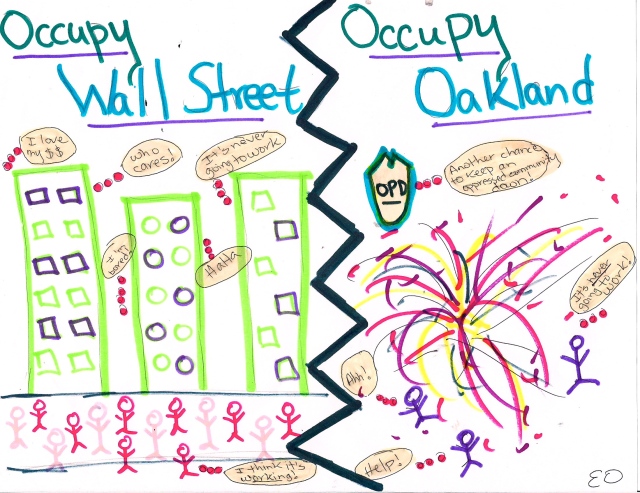This fall, the Oakland City Council debated adopting a new anti-graffiti law. The proposed law would make graffiti a misdemeanor, require property owners to remove graffiti on their proper within a certain time frame and hold the parents of minors fiscally responsible for the cost of graffiti removal. Inspired by Our America and Anna Deavere Smith’s Twilight Los Angeles, 1992, Life Academy freshman investigated the issue by conducting interviews and surveys throughout Oakland. Once the students gathered their data, they wrote assertion paragraphs for or against the proposed law. Below, please enjoy the strongest two assertions and several exemplary poems from each of the three sections of 9th grade English.
— Jill E. Thomas and Kyle Halle-Erby
_________________________________________________________________________________
For the Anti-Graffiti Law
The proposed anti-graffiti law should be passed by the City of Oakland because some graffiti brings violence. To begin with, there has been a lot of violence in Oakland with teenagers because of graffiti. Teens nowadays tag gang-related messages to claim their territories. For example, when we interviewed a random sampling of people, fifty-six percent of Oakland residents thought there would be less violence without graffiti. Less graffiti means less violence because people won’t be able to claim their territories by writing on the walls. Similarly, Brallan Munguia, a student at Life Academy, believes violence comes with graffiti. He said, “Yes, because if somebody crosses them out then he’ll be mad because he wasted a lot of time like drawing for somebody just to cross it out” (Munguia, 11/15/12). Graffiti creates anger among people, which can lead to violence. In addition, the city should pass the law because graffiti really does bring a lot of problems in this world. Rey Medina, a local tagger states that taggers start drama by doing graffiti. He states that “Yes, it’s called ‘funk’ because some people that tag get crossed out by some one else and the person gets mad and starts to want to fight them” (Medina, 11/23/12). Many of us connect to all of this because we have friends who tag and then someone who dislikes them cross it out, which brings even more anger and fights happen. We feel like without graffiti there will be less violence, but also it will be cleaner. If the law passes, youth would stop tagging on walls and books, so it would be less violence in schools too. Many people think Oakland is dirty and it must be because they see graffiti everywhere, even on trash cans. But, if the law passes, there will be less violence here in Oakland and more people will start liking it or will start coming to Oakland. Oakland is a unique place where people are proud to say they live, and not only live but were born and raised here. Forget what you heard and realize what you see.
— Cindy Montalvo (Student in 1st Period English)
Against the Anti-Graffiti Law
The proposed anti-graffiti law should not be passed because graffiti is one more type or art, not a sign of violence. To begin with, students at Life Academy surveyed Oakland residents and sixty-three percent of the people interviewed believe that there won’t be less violence with less graffiti. This shows that by decreasing the amount of graffiti in Oakland, we won’t be doing anything to decrease violence. Even though graffiti can be offensive to some people it doesn’t influence youth to be violent. To some people graffiti may be something that teens do because they’re bored and have nothing better to do. But to other people graffiti is art expressed through words. For example, a ninth grade students at Life Academy named Jacky Tril said, “I think it’s art, just that I don’t think it’s right where they do it” (Tril, 15 Nov. 2012). People in Oakland may see graffiti as vandalism because it is done on private property, but if we gave teens a place to do graffiti they wouldn’t do it on people’s property and people would see it more as art than vandalism. In addition, people in Oakland see graffiti as inappropriate and as a bad influence on children and youth. According to Carina Isidro, “I think they should pass this law because graffiti can be inappropriate…and the children see these things everywhere and I don’t think it’s right” (Isidro, 21 Nov. 2012). This law should only penalize people do offensive graffiti; instead it is penalizing everyone who does graffiti even if it’s not offensive. It would be hard to decide what type of graffiti is offensive because people have different opinions. But penalizing all graffiti artists would not be fair either. In conclusion, we can help our youth by giving them a place to do graffiti instead of taking it away from them. Taking away graffiti would be like taking away the voice of the unheard.
— Alondra Diaz (Student from 1st Period)
_________________________________________________________________________________
Art Doesn’t Kill
Anonymous, College student
(The interviewee, who wishes to remain anonymous, is wearing a black sweater and a black beanie. He speaks in a quiet voice, and changes speed as he talks. It is a Monday afternoon and it’s raining outside. We are sitting in the living room, it’s a beautiful house. All of the walls are painted sky blue and there is a painting of an angel on one of them.)
Graffiti:
Art or street art
That expresses who you are.
It expresses feelings
and some of it is
beautiful…
(Stands up and walks around)
It ain’t always just a bunch of words
and gang signs.
You know some of it,
Some of it is really creative
and its way different from what famous people do.
(sits down and takes out his phone)
You say they wanna take graffiti
away?
Why?
Graffiti ain’t violent
or nothing like that.
Is art and
art doesn’t kill.
Yeah they might think Oakland’s
gonna be cleaner
(Looks down and laughs)
That ain’t gonna happen…
You know why?
(Looks up)
‘Cuz Oakland ain’t dirty
violence is what makes it look bad.
–Alondra Diaz
Stupid
Fany Aguilera, Student at Arise High school
(sounds kind of sick, a lot of background noise, interview through phone)
It’s gonna be a boring city
Can you imagine San Francisco without its graffiti?
Yes
Imagine San Francisco without its graffiti
It would look like a hideous place
Like any other city in the world
…same with Oakland
(Coughs)
You’re going to get rid of
People who fuckin do graffiti and create
Monsters
Why the fuck would you wanna do that?
(Coughs)
It’s stupid
It’s stupid and unnecessary
There are things out there
That are far worse than graffiti and vandalizing
Like there are people getting
Killed
And they want to spend their money on stupid laws like that
Stupid
–Andrea Sigala
Hard To Say You’re Against Some Thing If You Fit In That Category
Edgar Rentira, Graffiti Artist Oakland Resident
(Age 17, Deep voice 9:30 Pm, interview done over the phone on 11/22/12)
As been a graffiti artist
I don’t see it as
Vandalism
I see as art just like painting,
music, dancing and etc is
Art
It’s like my first love
My first love
My first love
And my wife my first love
Ain’t nothing ever going
To change that!
My first love
(Starts to laugh)
Yes, I do beside I’m one of those
It’s just a life style I choose
I’ve done it for like a few
years now I gotta admit I’m like
in love with it!
unless it’s gang related
then it’s no art
it’s hard to say you’re against some thing if you
fit in that category!
that category!
— Hilda Chavez
Favor to the Law
Maria Tril, a former banker and a single mother of one
(Hair slick back, with a pale silky face. She’s sitting on the brown big couch with her legs crossed. Phone in on hand and she asks a lot of questions.)
Yeah,
When I was younger you say?
Sure
Of course I tagged. (she laughs)
Yes its art but it shouldn’t be used illegally.
What do you think?
No one should vandalize no ones property,
It should be made with someone’s permission.
Not everyone can do graffiti,
Some people know how to and some people don’t.
So no,
There’s no age limit.
I admire it.
It expresses people.
Not exactly to express themselves,
But to express something.
It should be known.
Know what I mean J?
I admire it.
But,
A favor to the law.
Law one point, graffiti zero.
So yes,
And expression
I could be pics, letters, or even some offensive shit.
But a favor to the law.
— Jacki Tril
Oakland is not a wall to graffiti!
Ms.Tie Ho, student life director of college track Oakland
(She in Asian. she has long black hair ,she is very short ,has a white polo shirt and wears blue genes she is very laidback and cam in her dig chair. has an old small watch she talks very fast)
Graffiti on the wall
the law should be pass you mostly see under
Bart, highways, old buildings,and stores
It may not affect you but it may associate with crime .
the citizens do not feel safe
Yes it art but it matters where you put
to compare Oakland and Hayward
Hayward is more respect and clean
when Oakland has graffiti
wherever
mostly everywhere
(moving her hands to one part of a table)
well ,it will be a good idea
Oakland is broke it a good way to get back
money that Oakland has lost
it should be pass the citizens do not want to see this
on their walls .
it a good idea
so pass it
to get money to the government
so
Oakland is not a wall to graffiti
— Jose J. Martinez
Trashy Neighborhood
Ana Luna, worker at WCC, mother of two
(Wearing white pajamas with black flowers print ,wrist watch on left hand, laying down in bed covered in blue sheets, T.V on the back ground, cell phone on her right side, we are in her bed room, there’s multiple clean clothes on a khaki couch.)
No,
I don’t like it when it’s not artistic
Oh, no
(mugs, scratches stomach.)
No.
The law? My opinion?
Well, yeah
I think the law should pass
Prevents vandalism
It looks…with a lot of graffiti
(thinks)
It makes it look like,
A trashy neighborhood
(takes a glimpse at her watch)
No
Because if they use graffiti in an artistic way,
It won’t affect them
Nice murals I businesses
It’s their job
It would only affect them those who use it
As vandalism
Vandalism
(yawns)
They would have to be more cautious
No
(cell phone rings, looks at cell phone awkwardly, ignores call)
(thinks)
Only with the condition
Of using it in an artistic way
No, they shouldn’t be able to
(shrugs, pretends to be sleep)
— Joselin Roque
Born To Do This
Gabriel De Leon, A young graffiti artist
(He is sitting on our couch in our living room. He wears a black sweater and beanie along with red shorts. He watches a movie, Friday, and plays around with our puppy. Laughs about movie and says quotes about the movie during the interview.)
I don’t see it as vandalizing
I see it as beautifying
The community
A structure of letters
Being expanded
With colors
And details
It’s a way of expression
I don’t see it as vandalizing
I see it as beautifying
The community
I feel like
I don’t know
It just feels good
It’s a way to release
My stress
I feel
Like I was born
To do this
I’m accomplishing
Something
I’m accomplishing
A talent
I’m going to keep
Doing
What I do
No
Matter
What
The law
Is
I don’t see it as vandalizing
I see it as beautifying
The community
— Karina De Leon
I Don’t Support the Law
Mr. Halle-Erby, Student teacher
(Wearing a grey sweater, Levi jeans, Brown boots, In Ms. Thomas’ classroom, Students talking in the background)
I don’t support the law
I don’t think the police need more reasons to bother people in Oakland
People who do graffiti
Like Latinos and Blacks
I think they wouldn’t go after white kids
Or hipsters that are doing graffiti
I don’t mind seeing graffiti
I like graffiti
Simple stuff
I like the ones that are drawings
Or simple pictures of people
I don’t like graffiti
That is just text all bubbly
I hate graffiti that is just sharpie
I think that makes things look junky
I like simple graffiti
That are just drawings
Or pictures of people
I think they do it because
They have something
They want to share
— Luis Zarate
Graffiti Is Not Appropriate
Yeni Prieto, Works for children with disabilities.
(A woman with black hair, she has her hair braided. She’s wearing sun glasses. She’s wearing pink earrings and a black jacket. We are at the park setting down on a picnic table.)
Yes, it could be art
when it’s performed at places
allow by the government.
Is okay as long you leave
a good positive message.
(She smiles)
But no, I don’t like graffiti
because it gives a bad
aspect to the city.
It mostly has inappropriate
figures or words
that makes the city
look dirty.
I guess… I guess that,
the gangs and teens
who have no adult
supervision and guidance
of good advice are doing this.
— Nayely Espinoza
Graffiti Everywhere
Ryneisha Culverson, 11th grader at Oakland Technical High school
(She is 16 years of age. She’s wearing a grey sweater with some Levi jeans, some chucks, and she’s laughing on the phone. She’s a very nice outgoing person. Her eyes light up like a light bulb when she’s happy! She does her own business in Downtown Oakland by making rings and selling them, her and her partner Briana made $171 dollars from the rings. She’s a very smart, intelligent leader.)
Sometimes,
It could be pretty
But
At the same time
You have to look pass the stupid
Stuff
If it has a meaning to it
Then yeah
It’s meaningful
And symbolizes something
It’s both ‘cause
Some people use it as artistic
Expression and other use it
To be ignorant I really don’t pay any attention to
It
It
Does bother me when I see
Businesses, malls, etc that people go to
And it has a lot of graffiti on it
Sometimes I be like
Why they do it?
It doesn’t matter to me
Because I don’t really care about graffiti
Everywhere
You turn your head you see
Graffiti
People use it for
Negativity!
— Rodriana Tillery
You Know
Anonymous, College Student
(Tall guy with long hair and dark sunglasses. Have a tattoo in his neck. White t-shirt with khaki short and black shoes. He’s Puerto Rican mix with black raise by grandmother. Has leave in Oakland more than 10 years. His on his 20’s.)
They try’na stop graffiti
Would since along ass time but
You know people don’t listen
(Laughing)
You know they try’na be
Cool
Would
There’s a lot of answers
You know its goanna be dad
For us
But for other people I think it’s going to be good.
You know
(Opens a beer but doesn’t drink it leave’s it in stairs)
Mmm…
Nope cause
You know how people is
They don’t listen
Eeeh
(Pointing at me)
And maybe would do it more often
You know
To feel that they bad
And that 50 (police) is nothing
(Shaking because it was getting cold)
Well cause
You see I’m more into what is now
I don’t think graffiti is a problem is
The people don’t really see what’s
The massage is for some of the graffiti
(Start moving around)
Well I think that graffiti make’s
Oakland looks UNIQUE
And
I LOVE it
You know
— Sindy Cox Perez
It’s Gonna Cause More Trouble
Anonymous, resident of Oakland
(We’re in her kitchen. It’s warm inside and she’s sitting on her couch while scrolling down on her iPod. I am sitting on a chair in front of her. There’s a Christmas tree in the left of me and a stove behind me)
Because they want to make it look
nicer
and they think graffiti is
bad
basically for the looks.
It’s a way of art
haven’t heard about it
it’s gonna cause more
trouble
kids underage will still
buy spray cans
you never see graffiti
in Alameda
or the Hills
but like,
definitely in poor places
it actually makes some places look
with color
with color
— Veronica Lopez













